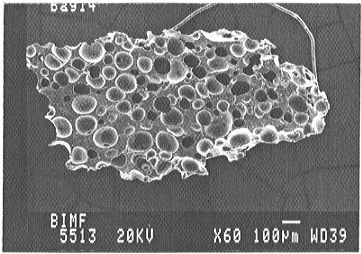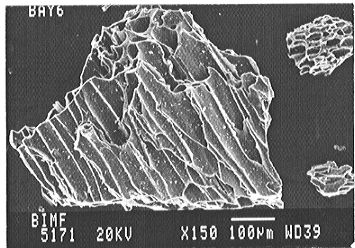

Explosive silicic volcanism is controlled by a complex interplay of physico-chemical properties, leading to a wide range of eruptive features. The processes involved in silicic eruptions mainly ensue from volatile exsolution during magma ascent and consequent drastic changes of the melt/fluid properties. Studies of hydrous silicate melt properties and rheology have been actively under investigation during the last decades, but magma vesiculation and fragmentation are much more poorly understood processes. The fragmentation bomb built in Bayreuth allows simulations of dome explosions under rapid decompression. This experimental device also allows the recovery of the fragmented particles for characterization.
This fragmentation study of a foamed melt involves two separate procedures: 1) melt hydration, 2) vesiculation and subsequent fragmentation experiment. 1) A dry synthetic powder of haplogranite composition is sealed with water in platinum capsules of 25 mm length and either 20 mm or 8 mm in diameter. The hydration is performed in an internally heated pressure vessel either in Orléans (ø 20 mm, 1.2 kbar, 950°C, 1 month) or in Hannover (ø 8 mm, 3 kbar, 1000°C, 3-6 days). The glass water content is homogeneous along the sample length and ranges from 1 to 6 wt%; 2) the hydrous glass cylinders are placed in the vertically-working autoclave of the fragmentation bomb for water vesiculation at pressures up to 180 bars and temperatures between 750 and 900°C. After 30 minutes at the desired pressure and temperature, the rapid decompression of the sample is induced by disrupting the diaphragm at the top of the autoclave. After experiments, the fragments are collected in the tank above the autoclave for grain and bubble size distributions, morphological study of the grains and pores, and determination of the melt water contents. Fragment sizes are up to 4 mm in diameter. The vesicularity range is up to 85 vol%. Bubble sizes vary up to 200 µm in diameter, exhibiting either rounded or tube-like shapes (Fig. 3.7-1a,b). Melt viscosities vary from 105.7 to 108.1 Pa s.
 |
|
|
 |
|
|
In these experiments, vesiculation has apparently occurred under near-equilibrium conditions between the dissolved and exsolved water. The pore morphologies reveal different bubble coalescence features mainly depending on the melt viscosity. The reasons for generating either isotropic or tube pumices are still under investigation. The plate-like shapes of the fragments are in accordance with a layer-by-layer spallation of the sample. The very angular outlines of the grains suggest a fragmentation at a brittle state of the melt. The grain-size distributions are in agreement with a single fragmentation event (i.e. conformed to the Rosin-Rammler law). By "isolating" the different pre-fragmentation parameters involved in the final grain size, we found that increasing either the pressure, the bubble size or the melt viscosity acts in decreasing the fragment size. We are now adding crystals to the melt in order to simulate the fragmentation of highly viscous microlite-bearing magmas.

Tel: +49-(0) 921 55 3700 / 3766, Fax: +49-(0) 921 55 3769, E-mail: bayerisches.geoinstitut(at)uni-bayreuth.de
 Previous page
Previous page